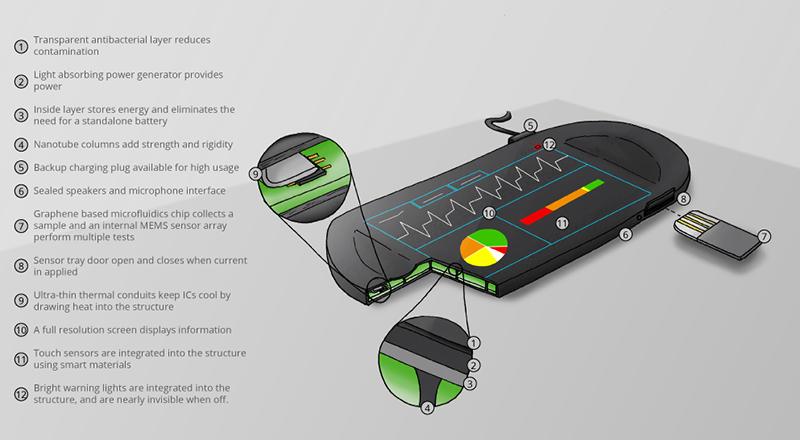Within the last year, graphene has been a hot topic in tech news. If you were to believe the articles, it can increase computing power, improve battery storage, replace batteries with super capacitors, enable transparent and smart textiles, improve MEMS sensitivity and effectiveness, make entirely new types of sensors, improve cooling systems, create higher resolution displays, and actuate mechanisms.
And the really jaw dropping fact: All of those articles are from a single journal from just a four-month period earlier this year. Developments are happening fast in the graphene world, with research centers all over the globe investing in the material. As with all futuristic medical technology, it will take a while to jump from the lab to the practical, but if it keeps up with this breakneck pace, graphene could be a $100 Billion industry at the core of our electronic devices in just a few years.
If you didn’t know already, graphene is made out of pure carbon. It differs from other allotropes of carbon (like coal or diamond) in its structure, which is to chemistry what cooking instructions are to ingredients: Both are equally important in defining the final product’s characteristics. Graphene’s structure, which gives it immense strength, is a crystalline hexagonal lattice (compared to a diamond’s cubic configuration) in which the carbon molecules are tightly packed and firmly connected to three of their neighbors. This composition gives it incredible strength and conductive properties. If you were to roll a sheet of graphene into a cylinder, you’d get a carbon nanotube, which is likely the strongest-per-pound material we’ve ever created. Graphene can not only make our consumer and medical devices stronger, it has the power to unlock a host of amazing new features.
The medical device of the future can be built with a layered graphene casing. The outer layer is transparent and antibacterial, reducing the threat of cross contamination by creating a hostile environment that destroys bacterial walls. Light can pass through it to get to the next layer: A power generating lamination that recharges the battery under ambient light. Graphene can also store energy, because the final structural layer acts as a battery by collecting energy like a superconductor and releasing it on demand. To add rigidity to this thin layered casing, carbon tubes are used as pillars, crossing the central void and making the device nearly unbreakable. Due to its magnetic properties, graphene also has applications in microphones and speakers, which can be built into the case to improve the user interface.

Also on graphene’s endless resume are applications in biosensing. A microfluidics chip with natural anti-clotting properties can read an input with accuracy and repeatability using next-generation graphene sensors. To keep dust out, a single-piece door covers the sensor input, and opens and closes electronically as current passes through. Integrated circuits in the device, which are prone to getting hot, can have the heat wicked away by thin thermal conduits that are built right into the wall of the device. Graphene conducts heat at ~4,000 W/mK, which is four times more than diamond (1,000 W/mK) and ten times more than copper (400 W/mK).
The device outputs information via a high-resolution screen backed by carbon LEDs, which have the potential to be cheaper and smaller than existing lights. These lights can be found elsewhere in the device to indicate warnings and alerts, capturing attention when needed and blending into the device when turned off.
Graphene also has applications in touch sensing technology, meaning not only are the display, lighting, speakers, microphone, battery, power generation and anti-bacterial layer built into the device, but the touch buttons are too.
Graphene is poised to revolutionize the medical industry. Al though the move from research to development never really goes as planned, the future of graphene-based medical devices is a whole lot closer than we might realize.







